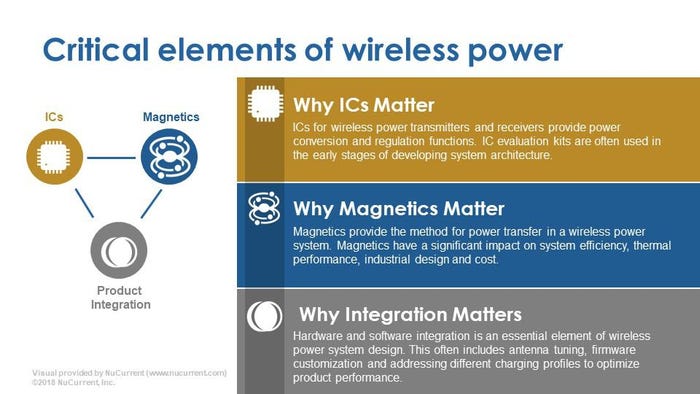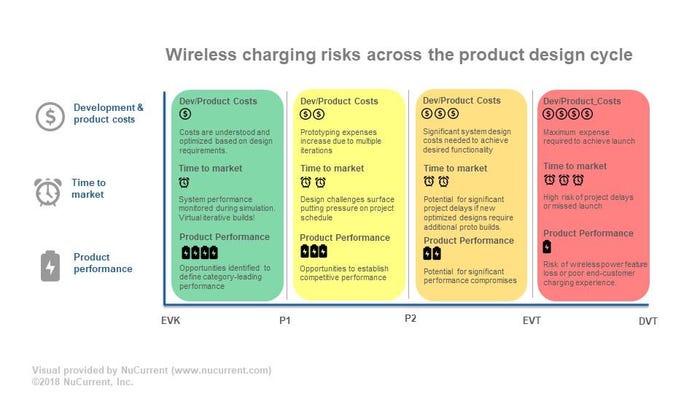Engineers developing consumer electronics, wearables, handheld computers, and other devices are actively considering how to include wireless charging into these devices.
September 4, 2018
Thanks to flagship smartphones from Apple and Samsung—and the addition of charging stations in places like coffeehouses, airports, and hotels—wireless charging has been gaining momentum with consumers.
Smartphones ushered in the era of wireless charging. But as more product designers are exposed to the technology, they are discovering use cases for new categories of products. Products including smartwatches, fitness trackers, hearing aids, earphones, sporting goods, apparel, handheld computers, and medical devices now have wireless charging in their specs.
Most product design teams have some (but not all) of the needed skills and experience to launch a product with wireless charging. Wireless charging still comes with some special considerations, however. Product teams developing consumer electronics, wearables, handheld computers, and other devices are actively considering how to include wireless charging into these devices. Therefore, it often makes sense to consult with a wireless power technology expert early in the product design process to ensure that the product launches on time, on budget, and with the desired level of performance.
Here are five things to be aware of when putting wireless charging into your product:
1.) Wireless Charging Is Difficult.
Apple and Samsung have led the way in developing products that offer wireless charging. These companies have large multidisciplinary teams of power engineers, RF/antenna engineers, mechanical engineers, and software engineers—all of whom influence some aspect of the wireless charging system. Even with sophisticated teams, wireless charging still poses challenges, as seen in capped charging rates and delays in product launches. Apple's AirPower pad is a prime example of this.
2.) Standards Can Be Helpful, but They Aren’t Critical.
In an industry-led push for interoperability, multiple wireless charging standards emerged. Chief among these is Qi (pronounced “chee”), which has become the de facto standard for smartphones. Qi is important and useful for cell phones and other flat devices that require charging infrastructure in cars, airports, and hotels. There are, however, many other wireless charging applications that don’t benefit from Qi and may not be possible with it. Some examples include hearing aids, sporting goods, and apparel. In these cases (and others), a high-frequency solution delivers a better design path and user experience. So product teams should consider a proprietary wireless charging design or one based on the AirFuel high-frequency standard.
RELATED ARTICLES:
3.) Chips, Magnetics, and Integration Are Critical.
Every wireless charging application has three critical components that contribute to successful implementation: integrated circuits (ICs), magnetics, and Integration.

ICs
IC selection is an important, early part of the design process, and engineers have a variety of options from manufacturers like IDT, NXP, Texas Instruments, and others. These ICs provide critical power conversion and regulation functions that can be tested using IC evaluation kits (EVKs), ideally in the early stages of developing the system architecture.
Design teams can often develop a false sense of security because the EVKs from the IC manufacturers work just as specified on the bench in free space. However, the moment that ICs, magnetics, and other components are integrated into a device, things can get very complicated. Power transfer levels drop, thermal issues crop up, and mechanical constraints become evident.
Magnetics
Magnetics provide the method for power transfer in a wireless power system, supplying the all-important connection from the charging surface to the device. In short, they put the “wireless” in “wireless power.” Magnetics also have a significant impact on system efficiency, thermal performance, industrial design, and cost.
Integration
Hardware and software integration is an essential element of wireless power system design. This often includes antenna tuning, firmware customization, and addressing different charging profiles to optimize product performance.
4.) It’s Way Better to Start at the Beginning.
Designing a wireless charging system comes with a range of engineering challenges. There are several critical activities related to magnetics and integration that impact cost, speed to market, and product performance (see chart below). When challenges are identified and resolved earlier in the cycle, risks to the project’s success are mitigated.

5.) Know the Risks Based on Where You Are in the Design Cycle.
There are three keys to developing a successful product: controlling development/product costs; time to market; and product performance. If you’re developing a product with wireless charging, the sooner you recognize that in the process, the better. In the chart below, you can see that the most favorable outcomes occur when the feature is brought in early in the process, whereas trouble looms if it’s brought in late in the game.

Mike Harmon is director of marketing of NuCurrent, an industry leader in wireless power systems and technology development. You can connect with Mike on Twitter and LinkedIn.
(All image sources: NuCurrent / MIke Harmon)
|
About the Author(s)
You May Also Like




